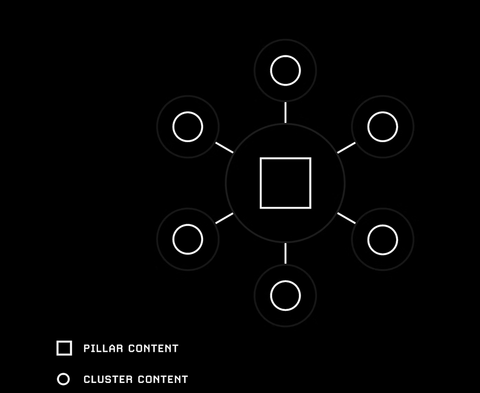Every day, Google serves 3.8 million searches per minute, 228 million searches per hour, and 5.6 billion searches per day.
In designing and implementing an effective SEO content strategy, you can drive high intending traffic from search engines, introducing your brand, products, and services to new audiences.
Attention that you can turn into revenue.
But creating content alone will not drive success, it's important to create an overarching SEO content marketing strategy that will support your goals and help you achieve success.
Here at Visualize Value, we have created Compound Content, a dedicated SEO course that walks through our own SEO strategy and process.
Since implementing the tactics outlined in Compound Content, we have seen an exponential rise in our organic search presence.
Here is a snapshot from our Google Search Console (we started implementing in August 2022).

Here we dive into the fundamental for creating an effective SEO content strategy, including a breakdown of the tactics you should implement when priotizing your own SEO efforts.
What is an SEO content strategy?
The fundamental objective of an SEO content strategy is to design a roadmap and plan for creating new content that ranks in search engines.
Effective SEO content strategies involve defining your market and target audience, analyzing your competition, completing deep keyword research on your niche, and designing a roadmap for creating SEO content that is optimized to rank in search engines.
The best SEO content strategies sit alongside broad SEO strategies that are designed to deliver excellent onsite user experience, drive high-quality backlinks to your website, and ultimately deliver revenue for your business.
Why is it important to create an SEO content strategy?
If you are looking to launch new content that you want to rank in search engines, it's impossible to drive success without understanding where search demand exists.
The great thing about organic search, is that your target market tells you what they care about, and how they want to look for the information they care about.
Your job as an SEO expert is to design and shape content that serves this demand, and turns that attention into your intended action (in 99% of cases, this means driving revenue).
Without an effective SEO content strategy, you can create content time and time again that does not meet search demand, and as such, largely goes unnoticed.
Avoid common SEO pitfalls with these 10+ tips and tactics for designing a winning seo content strategy.
1. Define your market and target audience
The first step when creating your SEO content marketing strategy is to define your target audience and the market you want to play in.
Here at Visualize Value our audience is made up of entreprenuers from a wide range of diciplines. This includes designers, marketers, builders, students, and so on.
It would be easy to get drawn into a scatter gun strategy when planning our SEO content strategy, attempting to to serve all of these sub-niches at once.
Instead, we focus on creating SEO content for broader topic areas that enable a wider range of entrepreneurs, regardless of their specific discipline.
This maintains our focus.
Right now, we're creating content on how to utilize SEO to drive website traffic. Later down the line, our strategy could evolve to include content on social media, NFT creation, or developing media partnerships (among other avenues).
If you are thinking about designing a search content strategy for an existing business, start with these top-level questions:
- Who are your current customers?
- What do they care about?
- How can you create value which helps them achieve their goals?
For those newer to the process that are looking to get a brand new project off the ground, these questions will help you start to define where you want to play.
- What do you care about?
- What do you do in your free time?
- What problems do you enjoy solving?
- What do you want to learn?
- What skills and qualifications do you possess?
- What is your unique leverage?
In running through this process, you will quickly start to identify ideas for generating search content, helping you define your target market.
The next step is to evaluate search demand.
2. Evaluate search demand
Once you identify the topic area that you want to create content for, it's important to understand how to evaluate search demand.
In doing so, you will achieve two things
- You will create content that attracts your intended target audience onto your website
- You will design content that targets the keywords and topic areas that drive high intending traffic, which you can monetize
Without understanding where search demand exists in your niche, you are operating blind, which leads to underperforming content and sub-par results.
Take these two examples.

The above screenshot shows the ongoing performance of a content asset we launched without an SEO content strategy (over 12 months ago).
There was nothing wrong with this content in terms of value or quality, but it was not written with an appreciation for SEO best practice.
While the page drives some clicks, it averages 20-30 impressions in Google per day.
Compare this to a post launched in the last month or so.

Here we can see an instant uptake in organic search impressions, driving roughly 6,000 search impression per day.
While this has yet to lead to organic search clicks. Once our average position starts to creep up, we will be left with a content asset that drives ongoing value for Visualize Value over time.
3. Keyword research
Underpinning the ability to evaluate search demand and map competitor performance is keyword research.
Keyword research tools like Semrush, AHREFs, and SE Ranking make it possible to understand quickly what people are searching for relative to your products and services, giving you the ability to start planning where to focus and prioritize your efforts.
Once you have identified overarching themes and topic areas that you are going to focus your SEO content efforts around, you can then start to identify the keywords that people are searching for relative to these topic areas.
For example, we create a lot of content to help entrepreneurs with search engine optimization (that's probably what led you here in the first place).
Search engine optimization as an overarching topic area gives us the flexibility to drill down and understand what people are searching for within this niche.
Here we can see that an important element when thinking about SEO is the process for designing content that ranks in search engines.
As such, it makes sense for us to create the content you are reading to serve this search demand.

Keyword research tools like Semrush and AHREFs make it easy to scan the keyword landscape and discover keyword ideas that you can create content around.
As you create more content on different areas of an overarching topic area, these individual cluster pages can be linked together to create topic clusters.
Topic clusters indicate authority to Google and will help your overall rankings. Read on for more information.
4. Evaluate the competition
In evaluating what people are searching for within your niche, you can also start to discover what content is already ranking and driving value for your target audience.
Not only does this give you the ability to understand how your competitors are positioning content to rank in search engines, but it will also provide you with a sea of new SEO content ideas.
Let's take the search term ' best hiking shoes' as a quick example.
This term is searched for around 20k times per month in the United States, and 32k times per month globally.

The top ranking page on Google for this search term is SwitchBackTravel, one of the case studies that we touch on in our dedicated SEO content course, Compound Content.
SwitchBackTravel is driving over 30k visitors per month from this search term, and ranking this page on over 2.5k unique organic keywords.
And they're not alone.
Here is a snapshot of the top 10 ranking sites for this search term.

Websites ranking in the top 10 search positions for this search term are receiving between 2k-30k visits per month, and ranking this page on between 500-2,500 keywords.
One great way to discover a large number of keyword ideas quickly is to look at the keywords that your competitors are ranking on at a site-wide level.
This will provide you with a breakdown of your competitors top-performing pages, helping you to further prioritize where you should focus your time.
5. Validate search intent
Before you begin creating SEO content it's important to write with an appreciation for search intent.
Search intent indicates to Google the intent of the searcher when searching for a keyword.
How Google and other search engines pereives this intent will drastically change the types of sites that are included in the top search engine results.
There are 4 different types of search intent to be aware of:
- Transactional intent - the searcher is looking to make a purchase
- Commercial intent - the searcher is still making up their mind relative to a purchasing decision
- Informational intent - the searcher is looking for information
- Navigational intent - the searcher is looking for a specific place on the internet
When creating SEO content it's a good idea to target keywords with search intent that match the outcomes you're looking to drive.
For example, if you are operating a retail business, it would make sense to target transactional intent, as people are looking for places to buy.
However, if you are an information site that is providing information pre-purchase then it's important to target commercial intent and information intent keywords.
Referring back to the previous example, check out the difference in search engine results for two very similar terms.
Here we see the top 10 search results for the search term, 'hiking shoes'.

Google displays retail businesses that are selling hiking shoes. Inferring that Google perceives this search term to be a transactional intent keyword.
Now let's look at the results for the term 'comfortable hiking shoes'.

Now Google serves comparison sites that have created content on the best hiking shoes, as Google is perceiving this keyword to represent commercial investigation intent.
Always scan the search engine results page to see what sites are ranking for the terms you are looking to target, this will guide you on the types of SEO content that you should create to rank for certain search terms.
6. Prioritize and plan SEO content strategy
As you begin identifying keyword ideas and evaluating competitors in your niche, you will get exposed to a huge amount of information and opportunity.
Before you beging creating content, it's a good idea to collect information on the keywords you identify so that you can start to prioritize your efforts.
Let's look again at the search term 'comfortable hiking shoes'.

Alongside the fact we can see that there are people searching for this term, we can also see other valuable information, including:
- Global search volume
- Keyword difficulty
- Clicks per search
- Traffic potential
- Parent topic
We can also see the top ranking competitor for this search term, which gives us the chance to dive deeper and understand the wider performance associated with this piece of SEO content.

We can see that Switch Back Travel are driving over 50k clicks per month from this page, which accumulates to around $30k worth of traffic value.
The page also ranks on another 3k keywords.
Finally, we can see that Switch Back Travel have a domain rating of 63, and a URL rating of 18, indicating the strength of their overall backlink profile, and backlink profile for this specific page.
It's a good idea to make a note of this information in Excel or Google Sheets. That way, when you have completed your keyword research, you can refer back and prioritize your efforts based on the metrics you care about.
Whether that be focusing on low difficulty keyword ideas or high search volume terms.
Our dedicated SEO content course, Compound Content includes a keyword research framework which helps with this process.
7. Create content
Now that you have a solid SEO content strategy, you're in a position to start creating content that will drive organic traffic.
Before you get started, we'd recommend that you utilize SEO content writing tools like SurferSEO or Clearscope to optimize your search content.
SEO content writing tools allow you to scan the search engine results page for your target keywords in order to pull back intelligence on the content that is already ranking for those search terms.
That way, when you are designing your SEO content, you can do so with guidance on how to structure your content, including what keywords (and keyword density) to include in your content, as well as insight into how you optimize your title tags and headings.
SEO content writing tools will also score your content as you produce it to help you benchmark how your content is stacking up in terms of quality vs your competition.
Here is a snapshot of this blog post being produced using SurferSEO (68/100 is by no means where this content will land when it's launched onsite).

For further information on how search engine algorithms read SEO content, you can also refer to our top SEO content writing tips.
8. Optimize on-page SEO elements
In addition to optimizing your SEO content using content writing tools, we'd also advise that you optimize on-page elements within your blog posts.
This means including your target keywords within your meta descriptions, SEO titles and headings tags.
Here is a snapshot of our title and meta description for our SEO content writing tips blog post.

We have included our focus keywords (SEO writing + SEO content writing) within our title and meta tag to clearly indicate to Google the purpose of our content.
Note, it's important to also focus on writing engaging meta tags that will drive click throughs onto your site - remember, this is your prime real estate when a user makes a search on Google.
In addition to focusing on optimizing your on-page elements directly, focus on avoiding thin SEO content or duplicate SEO content.
if you create pages in your sitemap that target the same groups of keywords in Google, this will lead to wasted effort and sub-par rankings.
9. Become a topic authority
When you are planning your SEO content strategy, it's a good idea to organize the SEO content that you are aiming to create into topic clusters.
Topic clusters are groups of content that are designed to work together to meet broad areas of search demand.
They are made up of a pillar page that broadly covers the overarching topic area, and then a number of cluster pages that are linked to both from the pillar page and other cluster pages.
Cluster pages allow you to explore areas of your sub-niche with more detailed information.
Here is a visual representation.

By planning your SEO content strategy in this way, you will force yourself into designing content that naturally links together and provides huge value for your audience.
The reason being, if someone is interested in a specific area like 'SEO content strategies', it's likely that they also care about 'SEO content writing' and a broad range of other sub topics that could help them further optimize their site.
In creating this breadth of content, search engines will see your SEO content resources as more valuable, and score them as a higher authority, leading to improved search rankings.
10. Refine user experience
When designing your SEO content strategy it's important that these efforts sit alongside a broader SEO strategy that ensures your overarching website is well-optimized and delivers an excellent user experience.
We'd recommend running your blog posts and pillar pages through Google's PageSpeed Insights tool to ensure that your pages are scoring well against Google's Core Web Vitals metrics, this will identify whether you have any user experience issues that are impacting your ranking performance.
Here's an example output using a blog post from Visualize Value in GSC.

Here you can see that our SEO Writing post is passing all Core Web Vitals tests, including Largest Contextual Paint, First Input Delay, and Cumulative Layout Shift.
If you are not passing Core Web Vitals scoring on desktop and mobile, then it's worth having a developer address the issues, as failing to pass these tests will have a negative impact on your rankings.
In the majority of instances, fixing these issues could be involve simple exercises like compressing media files or increasing text size on mobile, but there could also be wider issues in play that you need to address.
In addition to checking page level performance, it's important to also regularly audit your website using SEO audit tools like Screaming Frog or Semrush.
SEO audit tools will help you spot weaknesses in your overarching SEO strategy that could be holding your content back from driving organic traffic.
11. Build backlinks to your content
When building your SEO content strategy, it's important to think about how you structure your topic clusters to provide as much value and quality information for your target audience as possible.
After this, the number and quality of backlinks pointing to your website and content is still seen as the top ranking factor by SEO experts - driving site and page authority.
We are constantly evolving our link building strategy, implementing new and innovative ways to drive backlinks to our content.
Including PR outreach, through to guest blogging and creating new partnerships.
If you're just getting started, tools like Semrush and AHREFs allow you to audit your own backlink profile, and analyze which websites are linking to your competitors websites and key pages.
Here is a snapshot of the Visualize Value backlink profile in Semrush.

If you are looking to push a long-term SEO strategy that drives organic traffic, you need to think about the quality of backlinks that are pointing at your website.
Your link building strategy should focus on driving high quality backlinks, from high authority domains.
As you can see our link profile is made up of 86% follow backlinks, and has a low Semrush toxicity score.
If we do get linked to by websites with potential toxicity, these are identified and we can disavow them using Google Search Console.
12. Track and measure SEO content performance over time
Tracking and measuring your SEO content performance over time is vital to any successful SEO strategy.
Not only does this allow you to assess the impact of your SEO efforts over time, but it means that you can prioritize your focus on blog posts that are performing well, and make tweaks to articles that are not ranking or experiencing slow uptake.
It's a good idea to also constantly tweak your content to keep it up to date, relevant and a fresh resource for new visitors.
SEO tools like Semrush, SE Ranking, and AHREFs make it easy to assess overall SEO performance, and drill down to assess the performance of your top organic pages.
Here is a snapshot of the Visualize Value organic overview using Semrush.

As we start to implement out own SEO content strategy, we can assess the uplift in keywords that Visualize Value ranks for, as well as the organic traffic, and how our ranking profile is evolving over time.
We'd also recommend setting up rank tracking using a leading rank tracking tool. This will ensure that you can constantly monitor performance relative to your priority keywords.
13. Use Google Search Console to gain insight
Google Search Console is an exceptional tool for optimizing and tracking the performance of your SEO content.
Here is a snapshot of Visualize Value's organic search impressions in Google Search Console for the past 12 months.

As you can see, we have seen an exponential lift in the amount of organic search visibility to Visualize Value since implementing our the content marketing strategy outlined in our dedicated SEO course, Compound Content.
Once we have created SEO content, we ensure that it is indexed using GSC. From there, we track how certain blog posts are performing relative to the keywords that we are targeting.
This includes average position, click through rate, and clicks through to the VV website.
Google Search Console is also a great place to conduct keyword research.
As you design and launch new SEO content, you will find that your content ranks on a wide range of keywords outside of those you originally intended to target.
Add these terms to your SEO content strategy and broaden your topic clusters over time.
What to do now? How can I start creating SEO content right away?
Designing and implementing an effective SEO content strategy takes time, energy, and patience.
It's important to be consistent, to always deliver high quality content, and to focus on building out broad topic clusters that position you as an authority in your niche.
Combine these SEO content marketing efforts with an effective link building plan, regular site audits, and ongoing optimization.
This will put you in a great position to drive organic traffic for the long-term.
To check out our process at Visualize Value, you can sign up for our dedicated SEO course, Compound Content.
Compound Content dives into Visualize Values end-to-end SEO content strategy, including modules focusing on keyword research, content creation, and SEO best practises.
Related reviews of other SEO tools and courses









